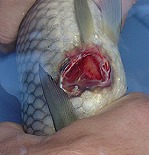
Aeromonas Bacterial Infections: What Should I Do About Bacteria?
Written by Dr Johnson

Aeromonas bacterial infections are not as simple as that.
You can’t tell by looking at a fish whether it has an Aeromonas infection, or whether perhaps it’s caused by Pseudomonas or even Stenotrophomonas multophila….
A culture can tell you which bacteria are present, but also; what medicine that bacteria is vulnerable to.
Aeromonas bacteria – A common bacterial pathogen of ornamental fish. This bacteria attacks any fish which is under any kind of stress, including overcrowding, overfeeding or parasitism. Aeromonas causes at least six different types (or presentations) of mortality (death) depending upon where in the fishes’ body it attacks. In the skin, we most often see red sores and bruises. Inside the fish, we’ll see abscesses and swelling. Behind the eye, the Aeromonas causes the eye to protrude. Without injection of antibiotics or the feeding of medicated food, Aeromonas is hard to control.
To learn a little more about Ulcers and Sores run a search on Ulcers or Sores.
Why You DON’T culture the surface of the fish
When you biopsy the fishes’ surface, you biopsy the fish pond. What’s ON the fish is a mix-n-match of every bacteria in the pond is NO commentary on what is actually IN the fish, killing it.
Can You Get an Infection From Swimming with Fish?
Bacterial infections from swimming with fish
Aeromonas, Pseudomonas, and their direct descendant, Stenotrophomonas maltophilia are all potentially but rarely infectious to humans who are older, or immune-compromised. It is interesting to note that if you treat Aeromonas and Pseudomonas with antibiotics, you can create resistant organisms so apparently different from their immediate ancestors that they call it Stenotrophomonas.
Aeromonas Infections In Wintertime. How does winterizing the fish help fight infections? How do infections gain access to the fish?
Chilling of fish in winter to near-freezing temperatures is extremely stressful to them. Carp are not native to temperate climates by origin. They simply “survive” our winters, but that doesn’t mean they’re adapted to it. Not only does near-freezing of fish annihilate their immune response, but it damages certain internal organ systems as well. In studies done by several Universities with fisheries departments, they found one of the most common ways that Aeromonas bacteria get into the fish in order to kill them was through the intestines! They showed that fish commonly suffer damage to the lining of the intestines when subjected to near-freezing water; and the Aeromonas uses this area of trauma to enter the fishes’ bodies. This partially explains the fact that Springtime is a common time of year for the majority of fish hobbyists to have health troubles with their fish. On the other hand, people whose ponds are heated all winter do not have a “Springtime” disease season. A great deal of technology exists to support water temperatures in winter.
Culture Technique for Regular People
The best culture for people to get, who are NOT scientists or veterinarians, is a blood or kidney culture. Obviously a kidney culture is a terminal event for the fish. Culturing the blood is VERY sensitive and does not sacrifice the fish. The blood culture is my favorite. And it’s easy once you know how to get the fishes’ blood.
